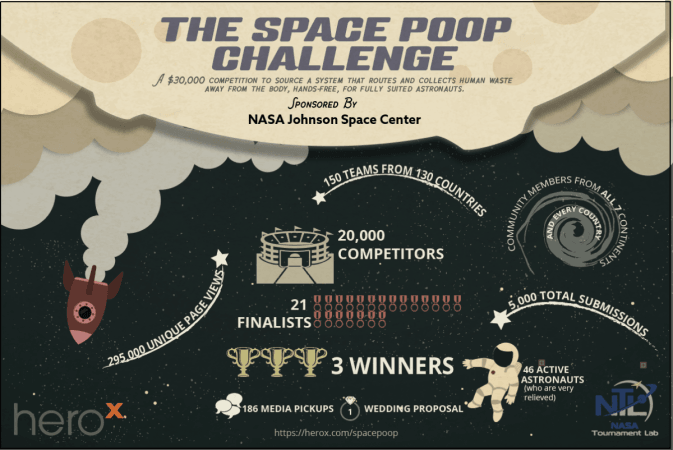
In October 2016, NASA launched a $30,000 USD worth of challenge called the 'Space Poop Challenge', to find a solution to aid astronauts in removing excreta hands-free in space.This 60-day long challenge by NASA was covered by HeroX.
Also Read: Iceland: Police asked tourists to keep their eyes off the sky!
"We are very excited to have had the opportunity to partner with NASA's Johnson Space Center on this challenge," said HeroX CEO, Christian Cotichini, said in a media release.
"The opportunity to contribute to future NASA missions by helping to protect astronaut health and safety, combined with the curiosity that surrounds performing the most basic of human bodily functions in microgravity, seemed like a perfect HeroX crowdsourcing opportunity," Cotichini stated further.
Though space is exceptionally huge, it is toilet-deprived and NASA is looking for a way to help manage the fecal, urine, and menstrual waste of astronomers once they are on a space flight.
Reason behind launching the Space Poop Challenge:
The space suits worn by the spacefarers are meant for safeguarding them from unpredictable conditions that can take place in space and also for launch and entry activities. The space suit is usually worn by the astronauts for up to 10 hours in a row during launching or landing takes place. In case of occurrence of any emergency in space, the astronauts are likely to wear the suit for up to 6 days.
As per the traditionally followed solution, the astronauts wear diapers in order to excrete, but this low-tech option doesn't last more than a day's time.
Alan B. Shepard Jr., the first American astronaut to go to space, he had to pee and he received a message from the control room saying "do it in the suit!" when he asked about how shouldhe relieve himself during the Mercury Redstone 3 mission, as per a report by spacesafetymagazine.com .
Insights about the challenge:
A total of 19,000 competitors registered in the competition and above 5,000 submissions were made globally, which comprised more than 150 teams from every continent including Antartica. After going through all the submissions carefully, NASA selected three winners and 21 finalists.
"The response to the Space Poop Challenge exceeded all of our expectations," said NASA Tournament Lab Deputy Director, Steve Rader, in a press release.
"The level of participation and interest went far beyond what we expected for such a short competition," Rader added.
And the winners are...:
The first prize was an amount of $15,000, which was awarded to Colonel Thatcher Cardon. This Air Force flight surgeon graduated from Brigham Young University in 1991 and works at 47th Medical Group, Laughlin AFB in Texas.
The second prize was won by a team comprising of three people, who were-- Stacey Marie Louie, Katherine Kin and Tony Gonzales. The team received $10,000 for their idea. Team member Stacey Marie Louie presently works at the University of Houston as an assistant professor in the Department of Civil and Environmental Engineering.
The third prize was won by Hugo Kelly, who is from Scotland and studied Physics and Philosophy at the University of Oxford and Kings College London.
The designs and ideas the winners came up with will not necessarily be used directly by the space agency, but the ideas and concepts provided by the participants will be used by NASA to devise and create elements that would help in resolving the issue.
These ideas and designs are likely to be incorporated in the forthcoming manned Orion mission.
Italian astronaut Samantha Cristoforetti how to use the International Space Station (ISS) toilet check it out:

















